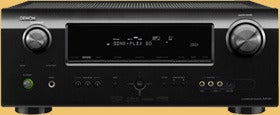Dolby’s brand new theatrical surround sound system, Dolby Atmos. I got to check out the new system at a showing of Brave at the SilverCity Yonge and Eglinton in Toronto, and the results are quite impressive. First off, the system is loud. Very loud. But it’s also the first time outside of an IMAX theatre where I’ve heard a sound system be this loud without also losing fidelity. This has everything to do with the way Atmos is designed.

Theatres have operated with what’s called 5.1 surround for a few decades now, and recently have been upgrading to a 7.1 system. Those numbers are simply an indication of how many separate audio channels a system can support. 5.1 has one subwoofer channel and five regular speaker channels; one in the centre, two on either side and two more on the sides of the cinema. There are often multiple speakers on the sides as well as the back walls, but these all share the same two channels of sound. 7.1 is effectively the same, except that it adds two more channels specifically for the back. A sound mixer on a movie now has control of a more full environment of sound. Dolby Atmos takes that control to a whole new level. Atmos can support up to 128 channels of sound plugged into up to 64 speakers. You don’t need to be good at math to know that’s a huge difference.
The number of speakers isn’t the only advantage, though. It’s where those speakers are placed. First of all, a lot more speakers lines the side and back walls. On top of this, behind the screen are said to be a bunch more speakers. The biggest change, though, comes from the rows of speakers lining the ceiling. In this case, one row of speakers on the left side of the ceiling pointed right down at the audience and another row on the right. I suppose the only way to surround the audience even more would be speakers beneath the seats.
So, given the theoretical power of Dolby Atmos, how did it actually sound in action? Well that’s a bit of a mixed bag.
Brave sounded great, and having already seen it in a standard Dolby Surround cinema I could definitely feel a difference. Where the regular surround was nice and loud and had some great spatial work, the Atmos mix was a set up. In general it felt much more like being in a full environment of sound, and though the volume was very loud, the mix of sounds from every channel was clear and distinct enough not to become overwhelming. The downside is that the movie had so much going on in the mix, particularly in the score, that it wasn’t always clear that every channel was being used. Here and there they did come through. Sounds seemed to rush overhead and right around the audience. In one scene, a character is talking as she moves from the right side of the screen to the left, and the sound very precisely follows her, which could be accomplished with three speakers, but sounded a whole lot better in Atmos.
I’m not sure
Brave was the best way to premiere the system, though. The constant score and mix of effects made it difficult to tell just how well the extra channels were being employed. I figure it doesn’t help that the Atmos mix for
Brave was done as a last-minute demo, not giving quite enough time to perfect it. The better demonstration of Atmos was the Atmos bumper before the movie started. A 3D sequence where the camera tracks through tree branches, with wind and wooshes and animal sounds coming from all directions. It was more than impressive, and I’m sure if built a bit better into the mix of a film the effect of the extra channels and the ceiling-mounted speakers would be amazing. A film like
No Country for Old Men, for example, would benefit greatly from Atmos, where you could plant the audience right in the middle of a soundscape, making it really feel like you’re traversing that desert, with sounds coming through the sides, and birds flying overhead.
Dolby Atmos isn’t a revolution in theatrical surround sound, but it’s pretty clear that if employed correctly, it will be something that the home environment simply cannot compete with. The power of the speakers and their sheer number and positioning would make for some pretty special sound mixes. It’s not a revolution, but it does take the surround sound we already know and love and raises it up a notch. Cinema has been about the experience of watching films for many decades, and Atmos is a great advancement in that experience. If all you want to do is see the picture and hear the words, you can do that at home. But if you want the best possible experience while watching a film, systems like Dolby Atmos make a big difference and truly enhance that experience










 Spade
Spade SBAN
SBAN Postmaster 25
Postmaster 25 Postmaster 33
Postmaster 33 Postmaster N3
Postmaster N3

















